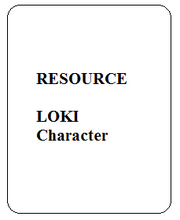
In Norse mythology, Loki is a god or jötunn (or both). Loki is the son of Fárbauti and Laufey, and the brother of Helblindi and Býleistr. By the jötunn Angrboða, Loki is the father of Hel, the wolf Fenrir, and the world serpent Jörmungandr. By his wife Sigyn, Loki is the father of Nari or Narfi. And with the stallion Svaðilfari as the father, Loki gave birth—in the form of a mare—to the eight-legged horse Sleipnir. In addition, Loki is referred to as the father of Váli in the Prose Edda.
Loki's relation with the gods varies by source. Loki sometimes assists the gods and sometimes causes problems for them. Loki is a shape shifter and in separate incidents he appears in the form of a salmon, mare, seal, a fly, and possibly an elderly woman. Loki's positive relations with the gods end with his role in engineering the death of the god Balder (Baldr). Loki is eventually bound by the gods with the entrails of one of his sons.
In both the Poetic Edda and the Prose Edda, the goddess Skaði is responsible for placing a serpent above him while he is bound. The serpent drips venom from above him that Sigyn collects into a bowl. However, she must empty the bowl when it is full, and the venom that drips in the mean time causes Loki to writhe in pain, thereby causing earthquakes. With the onset of Ragnarök, Loki is foretold to slip free from his bonds and to fight against the gods among the forces of the jötnar, at which time he will encounter the god Heimdallr and the two will slay each other.
Loki is attested in the Poetic Edda, compiled in the 13th century from earlier traditional sources; the Prose Edda and Heimskringla, written in the 13th century by Snorri Sturluson; the Norwegian Rune Poem, in the poetry of skalds, and in Scandinavian folklore. Loki may be depicted on the Snaptun Stone, the Kirkby Stephen Stone, and the Gosforth Cross. Loki's origins and role in Norse mythology have been much debated by scholars.
Background Notes[]

Loki is quite probably the most dynamic figure in Norse mythology being not only the spawn of the giant Farbauti and the giantess Laufey but also the blood brother of Odin. He is regarded as one of Aesir, but is on occasion their crafty and malicious enemy. Portraying seldom heroic aspects, he can be compared with the trickster from North American myths. Loki's mistress is the giantess Angrboda, and with her he is the father of three children: Jormungand the serpent, Fenrir the wolf, and Hel. The rascal also shows gender equality while shapechanging, mothering Odin's eight-footed steed Sleipnir. Sigyn is his wife who stayed forever loyal to him, even when the gods punished Loki for Balder's demise. He was chained to three large boulders; one correspondingly under his shoulders, loins, and knees. A poisonous snake was placed above his head. The dripping venom that lands on him is caught by Sigyn in a bowl and then emptied at a safe distance, allowing the poison that falls on Loki's face to make him twist in pain, causing earthquakes. Loki shuns weapons, preferring to utilize his gift of speech. In the event he needs a tangible device, persuasion suffices to acquire the object of his desire. Words, like Loki himself, can be wonderful allies or fearsome enemies, depending on the circumstances. As a positive revolutionary force, Loki brings equilibrium to Norse mythology.